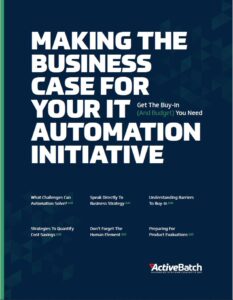Automation architect: What is it, and does your team need one?
The automation architect specializes in enterprise IT Automation, leveraging automation and existing IT tools to benefit the entire organization.

Automation architect jobs are popping up in mid-sized firms and large enterprises like AstraZeneca, HP and ADP. A quick search on Glassdoor, Indeed or LinkedIn confirms the trend: “We’re Looking for strong automation architects.”
But what exactly is an automation architect supposed to do, and how can you tell if your company needs one?
What is an automation architect?
An automation architect is a job function that aligns automation processes, tools and strategies with business goals. Automation architects work with department heads, stakeholders and IT teams to enforce best practices, standardize compliance and optimize automated processes.
ActiveBatch workload automation software
Build, monitor and manage business processes end-to-end in one workload automation platform with limitless integrations. See what you can achieve with ActiveBatch Workload Automation.
Why is automation important?
IT Process Automation is a critical capability for providing real-time services, reducing manual errors and getting more done with your existing resources. Automation is used in one form or another across departments and teams, and in many cases, an automated process will move data across the organization.
However, teams are often left to pursue automation independently of a larger, enterprise-wide initiative. This lack of oversight and institutional control can impede cross-silo cooperation and data sharing. As various departments implement a wide range of automation solutions, IT teams are stuck managing and supporting a bevy of new and legacy tools without any standard policies to reference.
For example, Gartner reports that most of its clients have at least eight automation tools which are “frequently deployed and utilized in silos, and may be duplicated.” At the same time, 80% of IT leaders report that silos are a major obstacle to their digital initiatives.
This is what automation architects are expected to amend.
What does an automation architect do?
Ideally, an automation architect is present from the beginning, implementing an automation strategy and procuring the necessary resources to make it happen. In most cases, an automation architect is hired to solve existing problems, especially in large enterprises.
To do this, an automation architect works closely with the CIO (whom they report directly to), the CFO, the CMO, the CTO, etc. The automation architect is a senior-level position that collaborates with senior stakeholders to determine and direct the business’s automation goals.
Once the automation architect has established a set of automation goals, he or she develops an automation initiative to guide the enterprise-wide implementation of new tools and processes.
It is up to the automation architect to determine what can be automated and when. For instance, it is often easier and more financially rewarding to automate file transfers before automating application releases. But if those files from the claims department are in dozens of different formats and have had an evolving set of standards over the last twenty years…
That isn’t something you can dump on a DevOps team or solutions architect. Someone needs to be in charge of overseeing the standardization that enables the automated processes which deliver critical services.
For the automation architect, standardization is a crucial part of the job. The automation architect sets enterprise-wide institutional standards and best practices for software configurations, documentation and testing. The automation architect also gets to work with his or her company’s compliance and legal teams to determine, for example, retention and business continuity policies for automated workflows.
Aside from establishing enterprise-wide policies and best practices, the automation architect is also an internal advocate for automation. Employees and managers can be reluctant to buy into automation (think job-security concerns and skepticism towards new technologies) and so the automation architect often plays a key role in voicing the benefits of automation.
Get the buy-in and budget you need for your IT automation initiative
Read five strategies that will help you build a business case for your IT automation goals.
What skills are necessary?
Communication skills are a must. The automation architect will need to brief business leaders on the opportunities afforded by automation. It is unlikely a CFO is familiar with server tasks and file transfer protocols. The automation architect will need to collaborate across departments, explaining the options available and working with other leaders to develop automated systems that address specific business requirements.
Those communication skills aren’t limited to briefing senior leaders. Automation architects often motivate business partners to implement automation solutions by explaining their benefits to employees, processes and growth.
As mentioned, part of the automation architect’s job is to establish goals from which he or she can develop an automation roadmap. Part of the reason for creating these goals is to establish quantifiable KPIs to illustrate progress, success and ROI. An automation architect should know how to measure and present quantifiable KPIs (or OKRs) to prove the benefits of enterprise automation.
Finally, an automation architect needs a deep understanding of current automation tools, processes and best practices. There’s a reason automation architects are becoming more popular, why enterprise architects and CIOs are not the ones managing automation architecture: enterprise automation is a dynamic, quickly changing field demanding its own expertise.
Automation architects must have a solid understanding of:
- API-driven integration
- Software development
- Agile methodologies
- Business processes
- Project management
Is An Automation Architect A Good Fit For Your Team?
Whether you work for a Fortune 500 or a mid-sized agency, many of your routine, manual tasks should already be automated. Automated workloads give employees the bandwidth they need to focus on high-priority tasks and long-term goals: automation is what allows companies to innovate beyond competition.
Every company with automation needs an automation architecture, though they might not need an automation architect, per se. An automation architect has a lot of responsibilities that don’t mesh with the job description of enterprise architects, CIOs or site reliability engineers. However, that doesn’t mean someone from the IT department can’t move into the automation architect role. For smaller companies unable to hire a new full-time position, expanding the role of an automation engineer or other personnel with years of experience within the company might make more sense.
There are many benefits to promoting an automation architect from within: that person already knows (or is at least familiar with) the business leaders, the corporate structure, etc. The automation architect needs to understand how the different business segments work together, how data and information flow through the organization and how existing IT infrastructure can be leveraged to support automation.
In many cases, automation architects are being hired to manage automation in specific departments or systems. For example, an automation architect might specialize in AWS, Python or Selenium—QA and testing automation architects are increasingly common job titles.
The automation architect position requires experience in IT infrastructure, communication skills and a deep understanding of the tools and software that drive enterprise automation. An automation architect needs to know where to find layered automation solutions that are versatile, extensible and highly compatible with today’s plethora of enterprise software. An automation architect needs to be able to leverage an automation solution designed for change.
Ready to simplify your data warehousing with workload automation?
Schedule a demo to watch our experts run jobs that match your business requirements in ActiveBatch. Get your questions answered and learn how easy it is to build and maintain your jobs.
Automation architect FAQs
An automation architect is a professional responsible for designing and implementing organizational automation strategies. They work closely with various department heads and stakeholders to align automation processes with business goals. Their role involves creating standardized procedures, ensuring compliance and optimizing automated workflows to enhance efficiency across the enterprise. Automation architects often collaborate with IT teams to select the right tools and technologies, addressing challenges and improving overall productivity.
Automation architects must possess strong problem-solving skills and a solid understanding of automation tools and best practices. They often have a background in information technology, software development or a related field and may hold certifications in areas like QA automation or RPA. Effective communication skills are crucial, as they need to articulate the benefits of automation to different parts of the organization, including senior management and technical teams.
Discover an architectural approach to IT automation.
Automation architects play a crucial role in DevOps by designing and implementing strategies that enhance the automation of development and operations processes. They work to integrate various tools and systems, fostering collaboration between development and operations teams. This integration helps create a more efficient workflow, enabling faster development cycles and more reliable software releases. Automation architects focus on orchestrating these processes to ensure they run smoothly and effectively.
In DevOps, automation architects need a strong background in software development and IT operations, often requiring knowledge of languages like Java and SQL. They are responsible for identifying opportunities for automation within the DevOps pipeline, such as automated software testing and continuous integration/continuous deployment (CI/CD) processes. By doing so, they contribute to the scalability and success of automation projects, ultimately helping organizations achieve their goals more efficiently.
Learn more about continuous integration and the role it plays in any high-performing DevOps department.
The automation framework architecture is a structured approach used to design and implement automated processes within an organization. It provides a set of guidelines, tools and practices that help create and maintain automation solutions. This framework typically includes various components such as scripting languages, test automation tools and reporting mechanisms. The goal is to create a cohesive system that allows for consistent, repeatable and scalable automation.
A well-designed automation framework architecture supports successful automation by promoting best practices and standardization. It often incorporates orchestration to manage and coordinate different automated tasks and workflows. Professionals working within this architecture may have a software testing or development background and hold a bachelor’s degree in a relevant field. This structured approach is crucial for industries like healthcare, where precision and reliability are vital.
Learn more about IT automation including motivations, benefits and tools.
The next big thing in automation is the increasing integration of artificial intelligence (AI) and machine learning (ML) into automation processes. AI and ML are being used to create smarter, more adaptive automation solutions that can learn and improve over time. This advancement allows for more sophisticated decision-making, predictive analytics and enhanced efficiency in automated tasks. AI-driven automation can optimize workflows, identify patterns and make real-time adjustments, a significant step from traditional automation methods.
Another emerging trend is the rise of hyper-automation, which involves using advanced technologies to automate as many business processes as possible. This includes everything from routine administrative tasks to complex decision-making processes. Hyper-automation aims to create a highly automated environment where technology handles repetitive and time-consuming tasks, freeing up human workers to focus on higher-value activities. As these technologies continue to evolve, they are expected to play a crucial role in shaping the future of automation.
Read about Gartner’s IT automation trends and which predictions came true.








